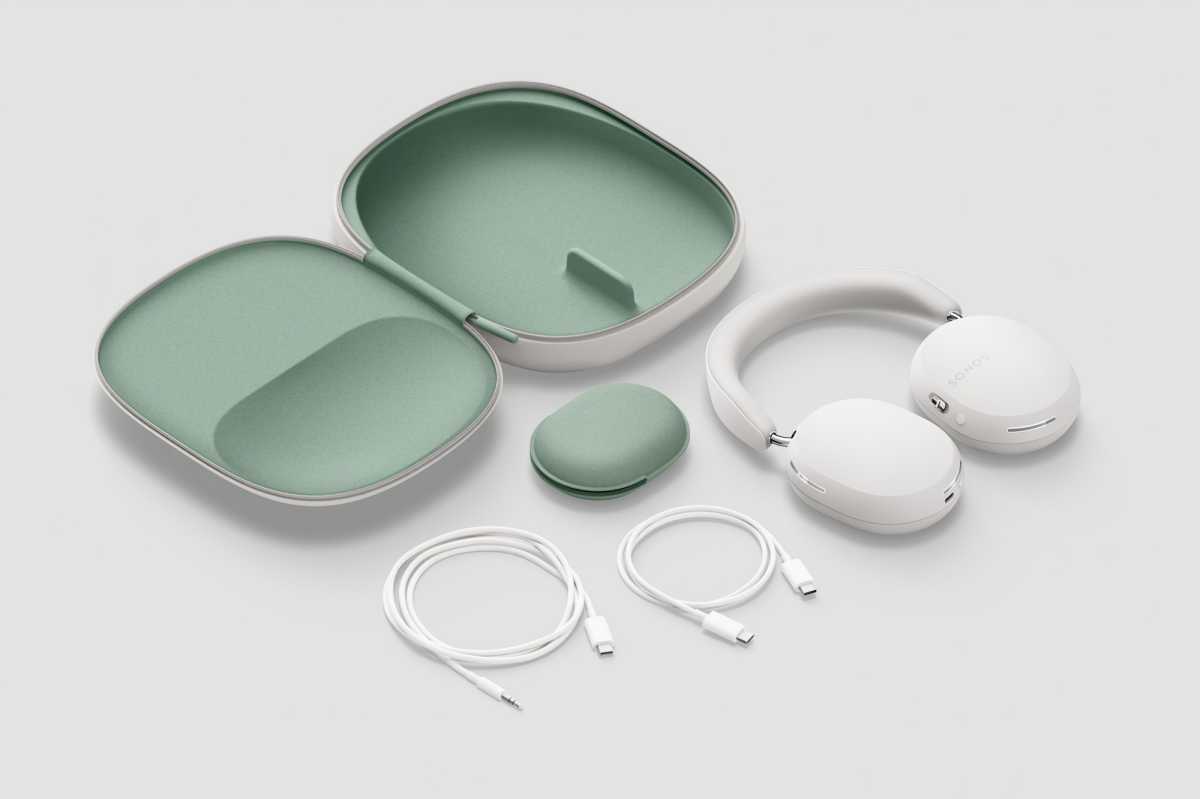Can a Sonos home audio product succeed if it’s isolated from the company’s synergistic networking ecosystem? We’re about to find out as Sonos wades into the crowded and hyper-competitive noise-cancelling headphone market with the $449 Sonos Ace.
The Sonos brand is nearly synonymous with whole-home audio, thanks to the company’s pioneering work building speakers and amplifiers that connect over wireless mesh networks, but its first headphones are based on Bluetooth 5.4, not Wi-Fi. As such, Sonos will be competing with such entrenched brands as Apple, Bose, Sennheiser, and Sony.
Sonos’ first cans will arrive—in black or soft white—on June 5. As befits a product in this price range, the Sonos Ace will feature custom-designed 40mm drivers; support for both Dolby Atmos and Sony 360 Reality spatial audio processing—complete with head tracking; and lossless audio decoding (including support for the Apple Lossless codec) with the included 3.5mm-to-USB-C cable, or over Bluetooth with an Android device that includes Qualcomm’s Snapdragon Sound AptX Lossless.
Sonos Ace active noise-cancelling headphones will be available in black and “soft white.”
Sonos
The Sonos Ace has eight onboard microphones, and Sonos characterizes the headphones’ active noise cancellation as “world class” (of course it does). Sonos also says its headphones will deliver an impressive runtime of 30 hours—with ANC on, with three minutes of rapid charging adding another three hours of listening time.
Will all that be enough for the Sonos fanboys? Given the maker’s history of envelope-pushing products, some of us have been expecting even more.
So, what’s missing?
Until now, Sonos—like Apple—has succeeded as a building-block brand, creating an interactive ecosystem of products. You’re lured into buying one of its audio-streaming speakers, network tuners, or amplifiers, and then crave more. That’s because these music makers don’t just look and sound good, they also connect and collaborate quite well, triggered by a unifying app and a “join” button on each speaker.
(Word to the wise: the recently revised Sonos app has several connectivity complications that are frustrating users and sparking long wait times on customer-support lines. You might want to hold off on the app upgrade for a few weeks for the bugs to be swatted or for better “How to do this now” fact sheets to be published.)
A multipiece Sonos system can get your whole joint humming, playing in perfect sync or with individual streams, as you prefer. The average Sonos customer winds up investing in three speaker setups (in my house they’re humming in six rooms.) And most of the current speaker models have microphones and smart assistants onboard, so smart-home owners can also ask them to lock the front door, turn off home lights, and activate their home security system, as well as call up tunes, podcasts, game scores, and more. Unlike modern Sonos speakers, the Ace won’t also function as a smart home controller.

Sonos Ace headphones with its cases and cables.
Sonos
After five years of hints and rumors, Sonos followers anticipated the company’s first wireless headphones would leapfrog the competition by functioning as a full-fledged member of the Sonos product family. That is, capable of pulling high-res content directly from the cloud with an utterance, thanks to voice recognition, the Sonos app, a subscription to a music-streaming service, and a network connection. Bluetooth connectivity would come into play when you’re out of Wi-Fi range. After all, Sonos already achieved as much with its portable Move and Roam speakers, which can run on either AC or battery power.
But it seems cramming an energy-hungry Wi-Fi adapter next to a Bluetooth radio and their respective antennas into the confined space of a headphone is even more challenging than accomplishing the same feat with a small speaker. Salt Lake City’s Streamz Media announced “the world’s first smart streaming headphones” in 2013, but still hasn’t brought the product to market. The Swiss audio company Hed Technologies delivered its Hed Unity Wi-Fi headphones to positive reviews late last year, after a couple CES prototype previews. But those cans drain their battery after just six hours, and the mind boggles at the $2,199 asking price tag.
Is less more?
In recent months, we’ve heard buzz that Sonos’ headphone development effort had been plagued with unspecified Wi-Fi operational problems, pushing out the Ace’s release date. But with sales of other Sonos products peaking, and CEO Patrick Spence’s repeatedly promising the financial community that Sonos would offer a blockbuster 2024 release in a previously untapped “multi-billion dollar category,” the company had to come up with a saleable product.
So, what to do? I’m guessing Sonos’ designers decided to lower their sights to deliver a single—and probably the least complex—Wi-Fi party trick: TV Audio Swap, “the Wi-Fi feature our customers put first on their wish list,” said Sonos Senior User Experience Designer Alexia Delhoume.
Using the low-power, short-range Wi-Fi Direct standard, TV Audio Swap allows an Ace headphone wearer to press the headphone’s Content Key button (or a touch point in the Sonos app) to mute a Sonos soundbar and re-route that audio stream to the headphones, instead. At launch, the Sonos Arc will be the only soundbar capable of this, but Sonos promises the feature is coming to its less-expensive soundbars, too: both generations of the Sonos Beam and the Sonos Ray.
This scenario could be ideal for night-owl movie and TV-show watchers looking to maintain good relations with a trying-to-sleep bedmate or a common-walled neighbor.

Sonos Ace users will be able to redirect the audio from a Sonos Arc soundbar to their Ace headphones. Later this year, every Sonos soundbar model will be capable of the same trick.
Sonos
Apple offers a similar feature with its Apple TV 4K streaming box: You can shift a soundtrack streaming from its set-top box to paired Bluetooth headphones. But Apple’s tech limits you to the sources and content available from the Apple TV, and Bluetooth generally doesn’t provide enough bandwidth for high-res audio.
With Sonos’ TV Audio Swap, you can feed the headphones any content flowing to and through the TV via its HDMI port or its optical input—and at resolutions up to 24-bit/48kHz. It’s also possible, I’m told, to shift over subscription music content you’ve been directing to the Arc, with no degradation in quality.
Ace users won’t be able to go roaming around the house, though; you’ll need to stay close to the Arc soundbar, given the limitations of its Wi-Fi transmitter and the Ace’s small Wi-Fi receiver. A more expansive set of Wi-Fi performance parameters might come with the next-gen Ace product, but Sonos isn’t laying its future roadmap on the table.
In addition to Dolby Atmos and Sony 360 Reality support, Sonos is promising a “groundbreaking home theater experience” when a software update (coming later in 2024) enables its TrueCinema technology. The company says TrueCinema will measure and virtually replicate the sense of your room resonance inside the Ace’s cushy cans, using a tuning process similar to the TruePlay custom tuning available on Sonos speakers. Audible “pings” will ring out from the Arc, and its microphones will capture the millisecond-delayed and diffracted response. Playback timing and phasing adjustments will be made to enhance the headphone’s spatial audio magic.
Does Sonos have a winning hand?
For certain, a goodly number of brand-loyal Sonos customers will bet on the Ace headphones, confident the product is attractive, adept, and long lasting (magnetically connected ear cushions are replaceable), with bonus points for enhancing their soundbar-zone playback experience.
But will the Sonos Ace also carry the brand’s panache, presence, and enough of an advanced feature set to attract consumers who’ve never bought into the Sonos ecosystem? And might they then stick around for more? That’s the multi-multi-billion-dollar question.




